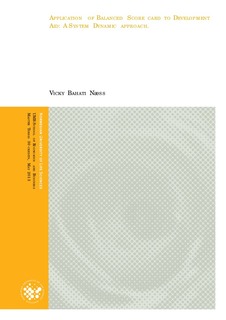| dc.contributor.author | Næss, Vicky Bahati | |
| dc.date.accessioned | 2013-08-05T10:15:26Z | |
| dc.date.available | 2013-08-05T10:15:26Z | |
| dc.date.copyright | 2013 | |
| dc.date.issued | 2013-08-05 | |
| dc.identifier.uri | http://hdl.handle.net/11250/187490 | |
| dc.description.abstract | Abstract
For years mechanisms have been implemented in attempt to improve aid effectiveness. The latest of these being the Paris Declaration established in 2005. However, years after the declaration there is little evidence of effective aid performance in Africa. Evidences of ineffective management of foreign aid are spread around Africa (Andrews 2009). Resulting in unintended effects like corruption and dependence on aid. Many of the unintended effects are associated with the way aid is administered from the donors, and therefore some of these negative effects may be minimized if the donors change their policies (Newby 2010).
The Norwegian aid agencies lack an effective management tool to assist decision makers in making effective policies. Following the Paris declaration alone is not enough. The objective of this thesis was to develop a Dynamic Balanced Scorecard (DBSc) model and demonstrate how it can assist decision makers in finding a more effective way of managing aid in order to reduce poverty. DBSc is a useful tool in assisting decision makers in evaluating the consequences of their policies before implementing them by using experimental computer simulation models. DBSc is not yet adopted by the Norwegian agencies. Norad was presented as a case study and Zambia as an example where a DBSc approach was applied. The thesis focused on development aid the Norwegian agencies allocated to Zambia from 1991-2011 for stimulating economic growth, improving both education and health sectors. The policies are about aid allocation per sector and they were evaluated depending on their effectiveness. Today’s policies and other policy alternatives were evaluated. The analysis of today’s policies suggests that they are not effective, confirming what is already known. The results from other policy alternatives suggest that development aid should be allocated to all the three sectors as they all contribute to a sustainable economic growth. Unequal distribution of development aid is recommended where the economic sector receives the largest share because the expenses involved in creating employment is greater than for building schools and clinics. The education sector should receive more than the health sector because it is assumed that an educated work force earns a higher average salary which leads to more tax revenues. This in turn contributes to economic growth. Aid effectiveness could benefit from better prioritization at the country level. The Zambian government should prioritize their development plan according to the benefits from each sector and this will change the allocation policies in Norway as those policies are influenced by the Zambian development plan.
Keywords: Balanced scorecard, system dynamics and development aid. | no_NO |
| dc.language.iso | eng | no_NO |
| dc.publisher | Norwegian University of Life Sciences, Ås | |
| dc.subject | Balanced Scorecard | no_NO |
| dc.subject | System Dynamics | no_NO |
| dc.subject | Development aid | no_NO |
| dc.title | Application of balanced score card to development aid : a system dynamic approach | no_NO |
| dc.type | Master thesis | no_NO |
| dc.subject.nsi | VDP::Social science: 200::Economics: 210::Economics: 212 | no_NO |
| dc.source.pagenumber | 97 | no_NO |
